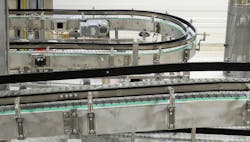From the United States, we awaited the arrival of the coronavirus with great trepidation, watching as countries overseas battled what would eventually become a global pandemic. Manufacturers raced to postpone normal operations, keeping workers safe and distanced, but many jumped at the opportunity to produce much-needed equipment and personal protective equipment (PPE).
[javascriptSnippet ]
The goods we convey
“Did Henry Ford envision the sophistication that industry could achieve in automating the production-line concept that revolutionized Ford’s manufacturing?” asks Bill Romick, Business Development Manager, C3Controls. “World wars, the Cold War, the Space Race, the technology races and world disaster have at times called for a complete pivot in factory output.”
The ubiquitous automation technology in every large-scale factory is the motorized conveyor, says Romick. “Converting an operation on the scale of an automotive factory from the intended product to something like a ventilator will still require a materials-handling system,” he explains. “The factory may elect to convert existing systems and components or to purchase new equipment. Conveyors, unmanned vehicles, packing and palletizing equipment, if automated, will require proper disconnect switches, motor controls, disconnects, circuit protection, safety interlock, emergency-stop and pilot indicator lights.”
Factory floor plans must observe regulations specifying proximity and access to power and motor disconnect and emergency-stop devices. “Options available to simplify production-line changes include off-the-shelf enclosed disconnect switches or enclosed emergency-stop switches,” explains Romick. “Other off-the-shelf components include enclosed motor-protection circuit breakers and enclosed direct-on-line starters.” Enclosed direct-on-line starters consist of the motor control contactor plus overload relay; or the motor protection circuit breaker plus contactor. Tag out/lockout features of the electrical/motor disconnect switch must also be considered.”
Within proximity to the operator must be pilot lights with prescribed colors indicating the presence of machine power, machine status and emergency status, says Romick. “Pilot-light devices are available in mutli-voltage ratings that simplify the retrofit task,” he explains. These devices operate at a variety of voltages and come in many sizes. Another indicator option is to install tower lights, which vertically stack the indicator lights and can include an audible signal, he adds.
Retooling a plant to manufacture or assemble a different type of product can be as simple as reprograming the PLCs or as complex as building a completely new line, says Daniel Weiss, senior product manager, Newark.
“A detailed analysis of the current state of the system that would need to be retrofitted, the given use cases and the requirements of the different stakeholders of the system are needed,” he explains. “In general, the concept of retrofitting aims at the partial re-working of subparts of existing systems, such as the replacement of large motors with new, more energy-efficient, smaller motors. Another option if reprogramming doesn’t work is to exchange old computers and PLCs for faster processing units.”
As automotive plants retool every year, the need to upgrade equipment to the latest Industry standard has most likely occurred during the most recent upgrade, notes Weiss. “However, the production line itself, because of the size of the equipment, will be different,” he explains. “The change in production size requires that there is enhanced inspection of the picking and sorting part of the manufacturing process. The goal is to ensure the efficiency, connectivity and profitability of the operations. The communication protocols in place remain effective, provided the PLC is programmed to read the data and send the needed instructions.”
In part 6 of this series of articles, we prepare for the future.
Mike Bacidore is the editor in chief for Control Design magazine. He is an award-winning columnist, earning a Gold Regional Award and a Silver National Award from the American Society of Business Publication Editors. Email him at [email protected].
About the Author
Mike Bacidore
Editor in Chief
Mike Bacidore is chief editor of Control Design and has been an integral part of the Endeavor Business Media editorial team since 2007. Previously, he was editorial director at Hughes Communications and a portfolio manager of the human resources and labor law areas at Wolters Kluwer. Bacidore holds a BA from the University of Illinois and an MBA from Lake Forest Graduate School of Management. He is an award-winning columnist, earning multiple regional and national awards from the American Society of Business Publication Editors. He may be reached at [email protected]

Leaders relevant to this article:


